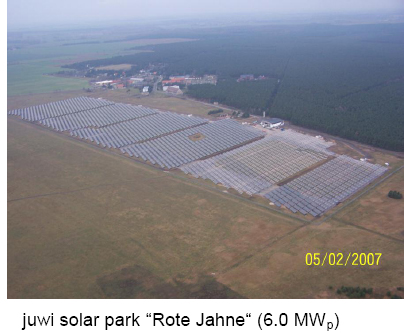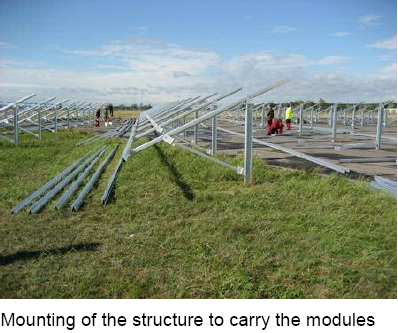
Juwi solar GmbH based in Bolanden (in the German state Rhineland-Palatinate) has put the final touches to the “Rote Jahne†solar power project in the district town of Delitzsch northeast of Leipzig. Connection to the electricity grid finalized construction of the large-scale photovoltaic (PV) project. With total output capacity of six megawatts, it is the fifth biggest PV installation operating in the world. It is also the world’s biggest solar project to use thin-film modules. The array will produce around 5.7 million kilowatt-hours of solar electricity every year, enough to power some 1,900 homes.
That also displaces the annual emission of 3,750 tons of carbon dioxide (CO2) into the environment. The PV power plant is built at a former military airfield; its module surface area comprises approximately 6.7 hectares – about the same size as 11 soccer fields. As the general contractor, juwi installed the entire turn-key project. Investment amounted to around 21 million euros.
The “Rote Jahne†PV power plant is based on state-of-the-art thinfilm technology made by First Solar.
“Thin-film modules have stood the test in many projects, are cheaper than crystalline modules and produce more energy per unit of installed capacity. We can clearly see that the skepticism that reigned two years ago has given way to higher demand. So its part in the overall market will increase distinctly in the future,†says Lars Falck, managing director of juwi solar GmbH. The array consists of more than 90,000 modules.
By why stop at 6 Mw? Near the “Rote Jahne†solar park juwi recently launched construction of the world’s biggest photovoltaic power plant. In the Muldentalkreis district the juwi company is installing a 40-megawatt solar park at a former military airbase in the townships of Brandis and Bennewitz. More than 550,000 First Solar thin-film modules will be used in an area comparable to 200 soccer fields. That project is due to be finished by the end of 2009.

In recent years the proportion of cleanly produced power in the supply has grown constantly in Germany. Wind, hydro, solar and bio sources now generate about 12% of the national supply. The federal government’s sustainability strategy aims at a 50% share of renewables in the middle of the century. The European Parliament demands a renewables proportion of 35% in the European supply by 2020. In Germany the Renewable Energy Sources Act (EEG) is the core instrument for implementing this strategy. It has developed into an elementary building block for securing and creating jobs. The German renewable energies sector employs about 170,000 people.
Germany is a leader in the use of solar energy, with 300,000 solar power arrays installed, amounting to a capacity of some 2,300 megawatts (status end of 2006). In 2006 PV power production rose 60% to some two billion kilowatt-hours. That makes photovoltaics the fastest growing energy source. Germany is the Number 1 on the solar market. In just a few years the stable political framework has made the solar industry an important employer in Germany. Photovoltaics enterprises employ around 50,000 people. Although the proportion of power produced by PV in the German supply is still small, studies by renowned institutes and enterprises (including the Shell corporation) assume that solar power production will become one of the most important future renewables. After all, the sun radiates more than 15,000 times more energy to earth than is used. Just 30 to 40 square metres are enough to keep a German household of four people supplied with power for a year. Solar energy can be deployed flexibly, in a large power station or as the only power source in areas not connected to a grid. Presently two billion people have no grid access. That offers a huge potential to enterprises, including German ones which due to promotion by the Renewable Energy Sources Act (EEG) have taken a leading position in the global solar market. Germany is well placed to become the world market leader in the manufacture of photovoltaic products (modules, assembly systems, etc.). Because of the massive potential, a market is developing which will outstrip the automobile industry by far. To maintain the impetus it will be necessary to keep the EEG in place in its present form for another ten years or so.
The Project At A Glance:
Approx. 6,000 kWp
Approx. 67,000 m²
(module surface area)
Annual production:
Approx. 5.7 mil. kWh
(equal to annual power demand of 1,900 households)
CO2 savings:
Approx. 3,750 tons/a year
Local value added from:
– Lease revenues;
– Tax revenues;
– New jobs.
One thought on “Worlds Largest Thin Film Solar Power Plant Opens”
Comments are closed.